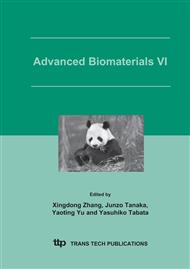p.541
p.545
p.549
p.553
p.557
p.561
p.565
p.571
p.575
Rheological Properties and Injectability of a Calcium Phosphate Bone Substitute Material
Abstract:
A calcium phosphate bone substitute material was prepared and its rheological behavior and injectability were studied in this work. The effects of temperature, L/P ratio and adjuvant on the rheological properties and injectability of the pastes were discussed. The results show that the calcium phosphate bone substitute material is injectable with good fluidity and is suitable for the clinical applications. The rheological behavior and injectability of the bone substitute material can be improved by adding adjuvants and optimizing L/P ratio.
Info:
Periodical:
Pages:
557-560
Citation:
Online since:
June 2005
Authors:
Price:
Сopyright:
© 2005 Trans Tech Publications Ltd. All Rights Reserved
Share:
Citation:


